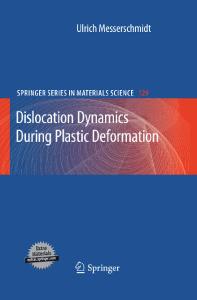Molecular Dynamics Simulation on Plastic Deformation of Nanocrystalline Copper
Molecular dynamics (MD) simulation is used to simulate the plastic deformation of a nanocrystalline model Cu sample with an average grain size of 5 nm containing 27 grains under high strain rate shear loading. Results show that the plastic deformation of
- PDF / 1,214,248 Bytes
- 11 Pages / 595.276 x 790.866 pts Page_size
- 90 Downloads / 402 Views
Molecular Dynamics Simulation on Plastic Deformation of Nanocrystalline Copper Lu Guo, Wang Shuaichuang, and Zhang Guangcai
Abstract Molecular dynamics (MD) simulation is used to simulate the plastic deformation of a nanocrystalline model Cu sample with an average grain size of 5 nm containing 27 grains under high strain rate shear loading. Results show that the plastic deformation of nanocrystalline copper can be divided into two parts: grain sliding dominated part, dislocation motion and grain sliding together dominated part. When the shear strain is less than 4%, the macro plastic deformation is the result of relative sliding of grains, grain rotation does not contribute to the overall plasticity, but it plays a supporting role in grain network adjustment. In this part, the deformation process can be described by viscous flow model. When the strain is greater than 4%, a large number of partial dislocations nucleate in grain boundaries and then slip into grains, most of them finally annihilate in corresponding grain boundaries and some deformation twins emerge near triple junctions. Therefore, the plastic deformation is the result of grain sliding, dislocation slipping and twinning. During shear deformation, shear planes involving several grain boundaries which are sub parallel to the loading plane have been observed. Keywords Molecular dynamics • Nanocrystalline copper • Plastic deformation • Grain boundary • Dislocation
27.1
Introduction
The mechanical properties of metals depend on the characteristics and properties of the internal defect structures. The plastic deformation mechanics of microcrystal is closely related to the behavior of dislocations, such as slip, reaction, proliferation and aggregation. A reduction in the average grain size results in an increase in the yield strength of metals, which is known as the Hall–Petch relationship [1]. When the average grain size is less than 100 nm, the percentage of grain boundary atoms is gradually increasing and dislocation behavior is suppressed, the relationship between yield stress and average grain size no longer meets the Hall–Petch formulation. Recent studies indicates that a further decrease in grain size (less than ~10 nm) can results in the weakening of metal and this weakening is referred to as the inverse Hall–Petch behavior [2]. In nanocrystalline metals, grain boundaries become a major defect structure and the size, type and network characteristics of grain boundaries determine their special mechanical properties, such as high yield strength, high fracture strength, superplasticity and so on. A quantitative clarification of the relationship between macroscopic mechanical properties and microscopic structures of nanocrystalline is a challenging work, because the details on grain size and its distribution, grain boundary type, grain boundary network characteristics, impurities and porosity are not well obtained experimentally, not only that, the mechanical properties of nanocrystalline is also affected by temperature, loading methods and rate. How
Data Loading...










